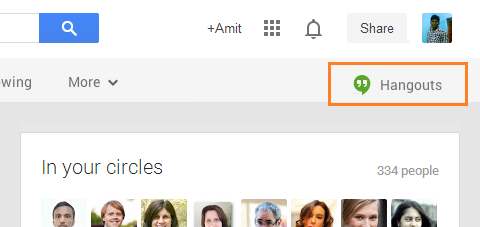
- #GOOGLE HANGOUTS HISTORY CACHE INSTALL#
- #GOOGLE HANGOUTS HISTORY CACHE FULL#
- #GOOGLE HANGOUTS HISTORY CACHE MAC#
WhatsApp originally did this to slow user growth to a manageable amount and cover the cost of sending initial SMS sign-up texts. Pre-Facebook acquisition, WhatsApp also answered the question of, "How do you make money with a messaging service?" WhatsApp made money through the innovative scheme of charging money-it cost $1 to sign up and $1 a year going forward. From 2009 to 2014, Google launched five different messaging apps.

From 2009 to 2014, WhatsApp built a messaging app worth $22 billion that boasted 450 million users. It's the perfect example of how harmful Google's lack of focus can be. WhatsApp was a company that was only five years old at the time and had only 50 employees, yet it ran rings around Google's messaging efforts (which is a truly embarrassing situation). Instead, Facebook's valuation of the messaging market was in a completely different league from Google's, and it turned the deal into one of the biggest tech acquisitions ever.

Google's $10 billion bid would have been the company's second-largest acquisition ever, after Motorola. There was apparently a bidding war going on, and, according to a report from Fortune, Google tapped out at $10 billion. It's hard to believe any of WhatsApp's denials since just a year later, the company really did end up selling-to Facebook-for a deal that ended up being valued at $22 billion. WhatsApp shot the rumor down publicly, calling it "not factually accurate." Next up was an April 2013 report from DigitalTrends saying Google was negotiating a WhatsApp buyout for $1 billion. The first bit of smoke was from a TechCrunch report in December 2012, saying that Facebook was sniffing around. The app doesn't have much of a presence in the US, but it is extremely popular in India, Europe, Africa, and Latin America. In late 2012, rumors started swirling that the then-independent company was taking acquisition bids. One more competitor-WhatsApp is now worth $22 billionīy 2012, WhatsApp had become one of the world's most popular messaging apps and was announcing explosive metrics like 10x more messages per day than it had seen the year before. The result is that while iMessage is great, you won't see it on a "most popular messaging services" list.
#GOOGLE HANGOUTS HISTORY CACHE INSTALL#
The hardware lock-in limits the install base iMessage can have, though, since not everyone wants or can afford Apple hardware. This also means Apple sees iMessage as a solvent business since more lock-in means more hardware sales. Apple is a hardware company, and you're supposed to only buy Apple products. Just like BBM, Apple views this as a type of lock-in, though. The big downside to iMessage is that it only works on Apple products, and there's no website, which is pretty limiting compared to the usual "works with everything" client smorgasbord from (good) Google products. It has group chat, end-to-end encryption (for iMessage messages), voice messages, FaceTime video calls, and a million other features.
#GOOGLE HANGOUTS HISTORY CACHE FULL#
We're not covering the full history of iMessage, but naturally having the full weight of Apple behind the service makes it a very competitive messaging app. I like to imagine Apple said something like, "Hey carriers, multiple partners means you are all now considerably less valuable to Apple! We're going to kill SMS. If you don't like it, there's the door." The truth, though, is that Apple didn't even feel the carriers were important enough to communicate with them. I think it's funny that this happened the same year AT&T's iPhone exclusivity ended and Verizon finally got to launch an iPhone.
:max_bytes(150000):strip_icc()/ChatandMeetTabannotated-a80cd11af01548adbba54b0d3e41efe7.jpg)
Carriers were apparently blindsided by the announcement of iMessage and Apple's commandeering of SMS. Cupertino couldn't care less about the feelings of AT&T et al. We'll later see Google acquiesce to the wishes of carriers and put SMS on a pedestal, but Apple was the polar opposite.

iMessage messages synced to your Mac, and eventually, SMS forwarding arrived in 2014, so I guess you can say that's when the service fully powered-up. Therefore you could use iMessage to communicate with everyone, no matter what. As Apple was fond of saying at the time: it just worked. Apple's service was the SMS client on iOS, but it also pushed people over to the enhanced iMessage service whenever possible. IMessage quickly became the template for what users wanted from a Google Messaging system. The full power of the company is behind iMessage with no other distractions. In fact, Apple has never launched a competing messaging app in the nine years this service has been around. Apple did not release a second, competing messaging app 18 months after the launch of iMessage.
#GOOGLE HANGOUTS HISTORY CACHE MAC#
End of article.Īpple launched iMessage along with iOS 5 in October 2011 and brought iMessage to the Mac with the release of OS X 10.8 Mountain Lion the next year. And now, a brief history of Apple Messaging services: iMessage.


 0 kommentar(er)
0 kommentar(er)
